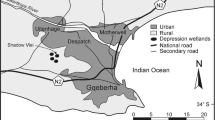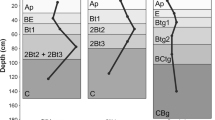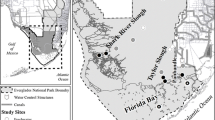Abstract
Observations at a discharge site in the Eastern Dundas Tablelands show that acid production and iron mobilisation contribute significantly to land degradation in addition to salinity caused by rising saline groundwater. Conditions at discharge are shown to vary markedly with position in the scald and time (both daily and longer periods). Silica and iron cementation of soil particles also occur. A framework is proposed to interpret these processes based on conditions at the discharge point for a reduced groundwater.
Similar content being viewed by others
References
Anda M 1996 Genesis and properties of a red and black soil association in the Monarto Area, South Australia. Masters of Soil Management and Conservation Thesis. Department of Soil Science, Waite AG. Research Inst., The University of Adelaide, Australia.
Fitzpatrick R W, Fritsch E and Self P G 1996 Interpretation of soil features produced by ancient and modern processes in degraded landscapes: V Development of saline sulfidic features in non-tidal seepage areas. Geoderma 69, 1–29.
Gardner W K, Fawcett J D, Fitzpatrick R W and Norton R M 2004 Chemical reduction causing land degradation I Overview Plant and Soil 395.
Horan J 1999 Colorado School of Mines, http://www.mines.edu/fs_home/jhoran/ch126/index.htm
Kozlowski T T and Pallardy S G 1984 Effects of flooding on water, carbohydrate and mineral relations.In Flooding and Plant Growth. Ed. T T Kozlowski p. 184. Academic Press.
Leathen W W, Braley S A and McIntyre L D 1953 The role of bacteria in the formation of acid from certain sulfuritic constituents associated with bituminous coal I Thiobacillus Thiooxidans Appl. Microbiol. 1, 61–68.
Leeper G W 1964 Introduction to Soil Science. pp. 174–177. Melbourne University Press.
Merry R H, Fitzpatrick R W, Spouncer L R and Davies P J 2000 Sideronatrite in acid sulphate soils in the Mount Lofty Ranges: First occurrence, genesis and environmental significance Proc. Soil 2000 Conf. on New Horizons in a New Century. Eds. A Metherell and P Williams. pp. 3–8. NZ Soc Soil Sci. Lincoln University.
Rayment G E and Higginson F R 1992 Australian Laboratory Handbook of Soil and Water Chemical Methods. Inkata Press, Melbourne.
Robbins E L 2004 Slide presentation about iron bacteria, cyanobacteria, and algae of kenilworth Aquatic gardens area, U.S. Geol. Survey. Patuxent Wildlife Research Centre. http://www.mp2-pwrc.usgs.gov/blitz/bionorslide.html
Vishniac W and santer M 1957 The Thiobacilli. Bact. Rev. 21, 195–213.
Water Services Ltd. 2002 Image ofleptothrix. http://www.arvanitakis.com/en/bio/leptothrix.htm
Author information
Authors and Affiliations
Corresponding author
Rights and permissions
About this article
Cite this article
Gardner, W.K., Fawcett, J.D., Fitzpatrick, R.W. et al. Chemical reduction causing land degradation. II Detailed observations at a discharge site in the Eastern Dundas Tablelands, Victoria, Australia. Plant Soil 267, 85–95 (2004). https://doi.org/10.1007/s11104-005-4687-9
Received:
Accepted:
Issue Date:
DOI: https://doi.org/10.1007/s11104-005-4687-9




